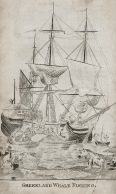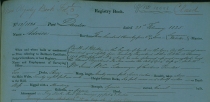Whaling Home | The Early Years | Next
The Arctic

Whaling in the Arctic was begun around the Spitzbergen Islands by the Dutch. By the time of British interest in the trade, whales were already becoming scarce. At this stage the fleet moved ever further westward in search for new sources. Eventually, the northeastern coast of Canada became the most important area for the nineteenth century whalers. The Straits (Davis Straits) or Baffin Bay were the summer homes of the migrating right whales, which the men also called the bowhead or black whale.

East coast ports in both England and Scotland were the home of almost all Arctic whalers. Ports like Hull, Whitby and Newcastle in England led the way with the largest fleets. Along the Scottish east coast, although numbers of actual vessels were less many small ports had at least one whaler. Peterhead, Dundee and Aberdeen took the lead but vessels also sailed from Leith, Bo'ness, Kirkcaldy, and Montrose. By the 1840s whales were becoming scarce. There was also a reduction in the traditional demand for oil as a form of street lighting as gas was introduced. This resulted in many ports giving up the trade.